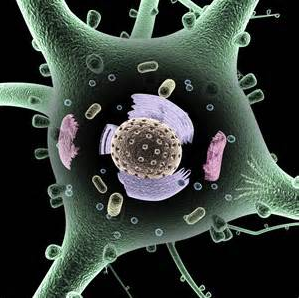技术专题
The FASEB J:线粒体“盾牌”可帮助癌细胞持续旺盛地存活

近年来科学家花费了巨大的精力去研究为何癌细胞如此具有“弹性”,即便是在其面对毒性药物、放疗甚至是机体免疫系统时依然可以死灰复燃;近日,一项刊登在国际杂志The FASEB Journal上的研究论文中,来自俄罗斯科学院的研究人员通过研究表示,由一种波形蛋白(VIF)形成的中间丝(intermediate filaments)可以使得癌细胞中的线粒体有效地被保护以免于损伤。
在正常情况下,VIF可以作为细胞的骨骼来帮助维持细胞的形状,而在癌细胞中,VIF则会帮助保护癌细胞的能量供给中心—线粒体,其可以帮助癌细胞抵御来自外界的各种攻击,由于许多癌症疗法可以靶向作用癌细胞的线粒体,因此本文研究或将帮助研究人员开发出有效治疗癌症的新型药物。
研究者Alexander A. Minin博士表示,此前研究人员在某些肿瘤细胞发生恶性转化的过程中发现了波形蛋白的表达,自从那时起这种蛋白就被用作临床诊断的生物标志物,然而波形蛋白在促进癌症转移上的角色至今尚不清楚;我们的研究就解决了这一问题,研究者发现,肿瘤细胞能动表型的获得需要线粒体增强能量的产生,而VIFs则会通过增加线粒体膜的跨膜电位(MMP)来完成这个任务。
文章中,研究者利用潜在的荧光依赖性线粒体燃料来分析培养中细胞的MMP,这些燃料可以在线粒体中按照MMP的水平来按照比例积累,MMP水平越高,线粒体的染色就越亮;为了调查VIFs在MMP调节中的角色,研究人员对比了不含VIF的细胞和VIFs水平恢复的细胞中线粒体染色的荧光强度,在逆实验中,研究者发现,在包含VIFs的正常细胞中通过RNA干扰的方式可以抑制细胞中波形蛋白的表达,总的来说,MMP在VIF存在的时候水平会增加,同时VIF的缺失则会引发跨膜电位水平下降。
最后,杂志主编Gerald Weissmann说道,长期以来我们都知道癌细胞会对有机体带来灾难性的破坏,而且其具有较强的“弹性”,而这项研究可以帮助我们解释为何癌细胞具有这样的特性,如今我们都知道癌细胞的蛋白骨架不仅可以帮其维持形状,而且还可以保护储备能量的能量库,后期科学家们获将开发出靶向作用癌细胞的新型疗法。
Mitochondrial membrane potential is regulated by vimentin intermediate filaments
Ivan S. Chernoivanenko*, Elena A. Matveeva*, Vladimir I. Gelfand†, Robert D. Goldman† and Alexander A. Minin*,1
This study demonstrates that the association of mitochondria with vimentin intermediate filaments (VIFs) measurably increases their membrane potential. This increase is detected by quantitatively comparing the fluorescence intensity of mitochondria stained with the membrane potential-sensitive dye tetramethylrhodamine-ethyl ester (TMRE) in murine vimentin-null fibroblasts with that in the same cells expressing human vimentin (∼35% rise). When vimentin expression is silenced by small hairpin RNA (shRNA) to reduce vimentin by 90%, the fluorescence intensity of mitochondria decreases by 20%. The increase in membrane potential is caused by specific interactions between a subdomain of the non-α-helical N terminus (residues 40 to 93) of vimentin and mitochondria. In rho 0 cells lacking mitochondrial DNA (mtDNA) and consequently missing several key proteins in the mitochondrial respiratory chain (ρ0 cells), the membrane potential generated by an alternative anaerobic process is insensitive to the interactions between mitochondria and VIF. The results of our studies show that the close association between mitochondria and VIF is important both for determining their position in cells and their physiologic activity.—Chernoivanenko, I. S., Matveeva, E. A., Gelfand, V. I., Goldman, R. D., Minin, A. A. Mitochondrial membrane potential is regulated by vimentin intermediate filaments.
